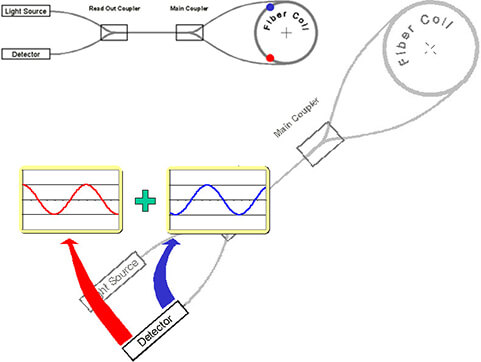A gyroscope is a device used for measuring or maintaining orientation and angular velocity. It consists of a spinning wheel or rotor that is mounted in such a way that its axis can assume any orientation. When spinning, the orientation of this axis remains stable, regardless of any motion of the base of the gyroscope, due to the conservation of angular momentum. This principle is harnessed in various applications to detect changes in orientation, such as in navigation systems, aerospace, consumer electronics, and robotics.

How a Fiber Optic Gyro (FOG) Works:
A Fiber Optic Gyro (FOG) utilizes the interference of light to detect changes in orientation and angular velocity. Here's a detailed explanation of how it operates:
-
Light Source:
- A coherent light source, typically a laser diode, emits light which is split into two beams by a beam splitter.
-
Propagation Through Fiber Coil:
- The two light beams travel in opposite directions through a long coil of optical fiber. This coil can be several kilometers long, with the light making multiple turns through the fiber. Due to the Sagnac effect, any rotational motion causes a difference in the phase between the two beams.
-
Interference:
- As the beams recombine after traveling through the fiber coil, they interfere with each other. The phase difference induced by rotation results in constructive or destructive interference, which can be measured as a change in intensity of the recombined light.
-
Detection and Processing:
- The interference pattern is detected using a photodetector. The output signal, which varies with the rotation rate, is then processed by electronics to determine the angular velocity of the gyro.
Advantages of Fiber Optic Gyroscopes:
- High Accuracy and Stability: FOGs provide precise measurements and exhibit low drift over time.
- Robustness and Reliability: With no moving parts, FOGs are highly durable and less prone to wear and mechanical failures.
- Wide Range of Applications: Due to their reliability and precision, FOGs are used in aerospace, marine navigation, robotics, and various industrial applications.
In summary, a gyroscope is a device that measures orientation and angular velocity, while a Fiber Optic Gyro makes use of the interference of light traveling in opposite directions through a coil of optical fiber to detect changes in rotation. The precise and robust nature of FOGs makes them suitable for a wide range of navigational applications.
